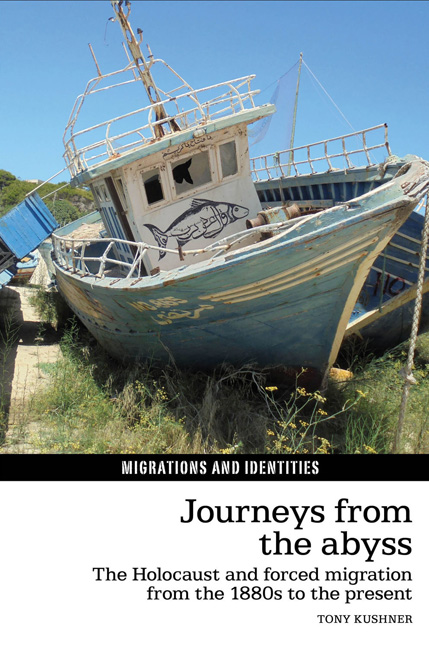Book contents
- Frontmatter
- Dedication
- Contents
- Preface and Acknowledgments
- Introduction: Migration and the Holocaust
- Part 1 Gender, Forced Migration, and Testimony: From ‘White Slavery’ to ‘Trafficking’ via Refugee Domestic Servants
- Part 2 Place, Performance, and Legality: Holocaust Survivors and Other Migrant Journeys in the Long Twentieth Century
- Conclusion
- Bibliography
- Index
Introduction: Migration and the Holocaust
- Frontmatter
- Dedication
- Contents
- Preface and Acknowledgments
- Introduction: Migration and the Holocaust
- Part 1 Gender, Forced Migration, and Testimony: From ‘White Slavery’ to ‘Trafficking’ via Refugee Domestic Servants
- Part 2 Place, Performance, and Legality: Holocaust Survivors and Other Migrant Journeys in the Long Twentieth Century
- Conclusion
- Bibliography
- Index
Summary
Uniqueness, Jewish Refugees, and the Perils of Hindsight
In 1936 the political and economic status of the combined six million Jews of Germany, Poland, Romania, Latvia, Lithuania, and Austria was ‘neither life nor death’. For them the world was ‘divided into places where they cannot live, and places into which they cannot enter’. Chaim Weizmann's pithy and politically effective contribution to the British government's Palestine Royal Commission (1936–7) has subsequently gained iconic status. Much quoted, the statement of the great Zionist leader and first president of the State of Israel is presented as having foreseen the acute dilemma of European Jewry, especially with persecution and discrimination – and immigration restriction – intensifying in the last years of peace. Weizmann then appears to have predicted the devastating destruction that was to follow during the Second World War.
Referring to the 1930s, Abba Eban, Israeli minister and leading diplomat, in his My People: The Story of the Jews (1968), briefly mentioned those who had been turned away from places of refuge, such as the German Jews on the St Louis: ‘No American country would admit them, and the ship finally returned to Europe.’ Other boats sank, such as ‘the “Capo” [sic] with 750 Jewish refugees aboard’. Indeed, there are no examples given in his simplistic narrative of successful refugee rescue except for those who reached Palestine. And it is in this context that Weizmann's Royal Commission evidence on the future of Palestine was not only reproduced but also embellished by Eban: ‘There are six million people doomed to be pent up where they are not wanted and for whom the world is divided into places where they cannot live, and places where they may not enter. Six million!’ It is no surprise – given Eban's embellished repetition of this subsequently infamous number – that he concluded that ‘In eight years’ time, the problem presented by these six million Jews was to be solved. In 1945, these six million were dead.’ The scale of the Holocaust has led to its history being read teleologically, especially by those with a strong ideological commitment.
Frank Caestecker and Bob Moore have noted that, in spite of many other cases of forced migration in the twentieth century and beyond, ‘it is the refugees from Nazi Germany in the 1930s that have received by far the greatest attention from historians, social scientists and demographers’.
- Type
- Chapter
- Information
- Journeys from the AbyssThe Holocaust and Forced Migration from the 1880s to the Present, pp. 1 - 36Publisher: Liverpool University PressPrint publication year: 2017



